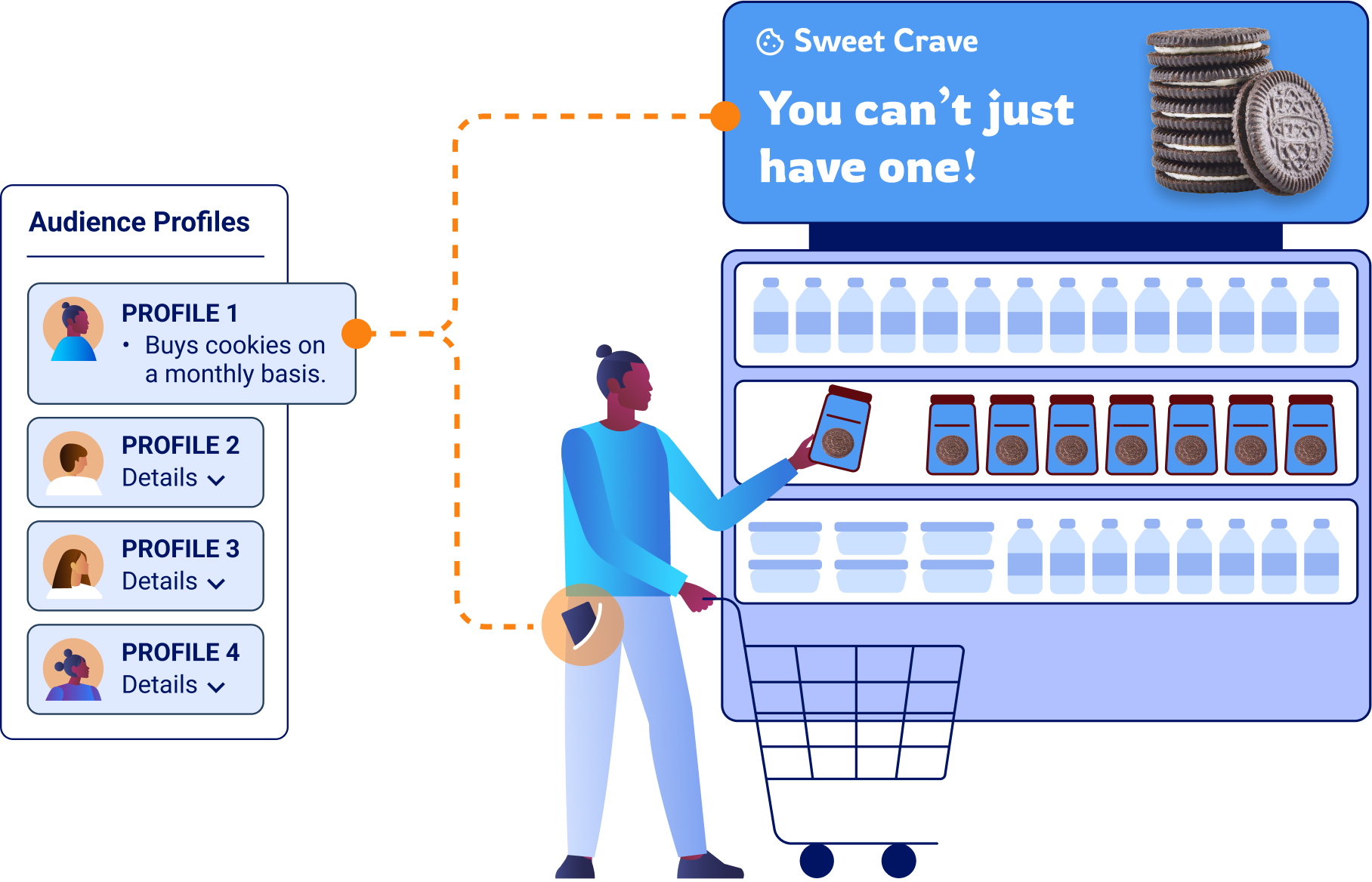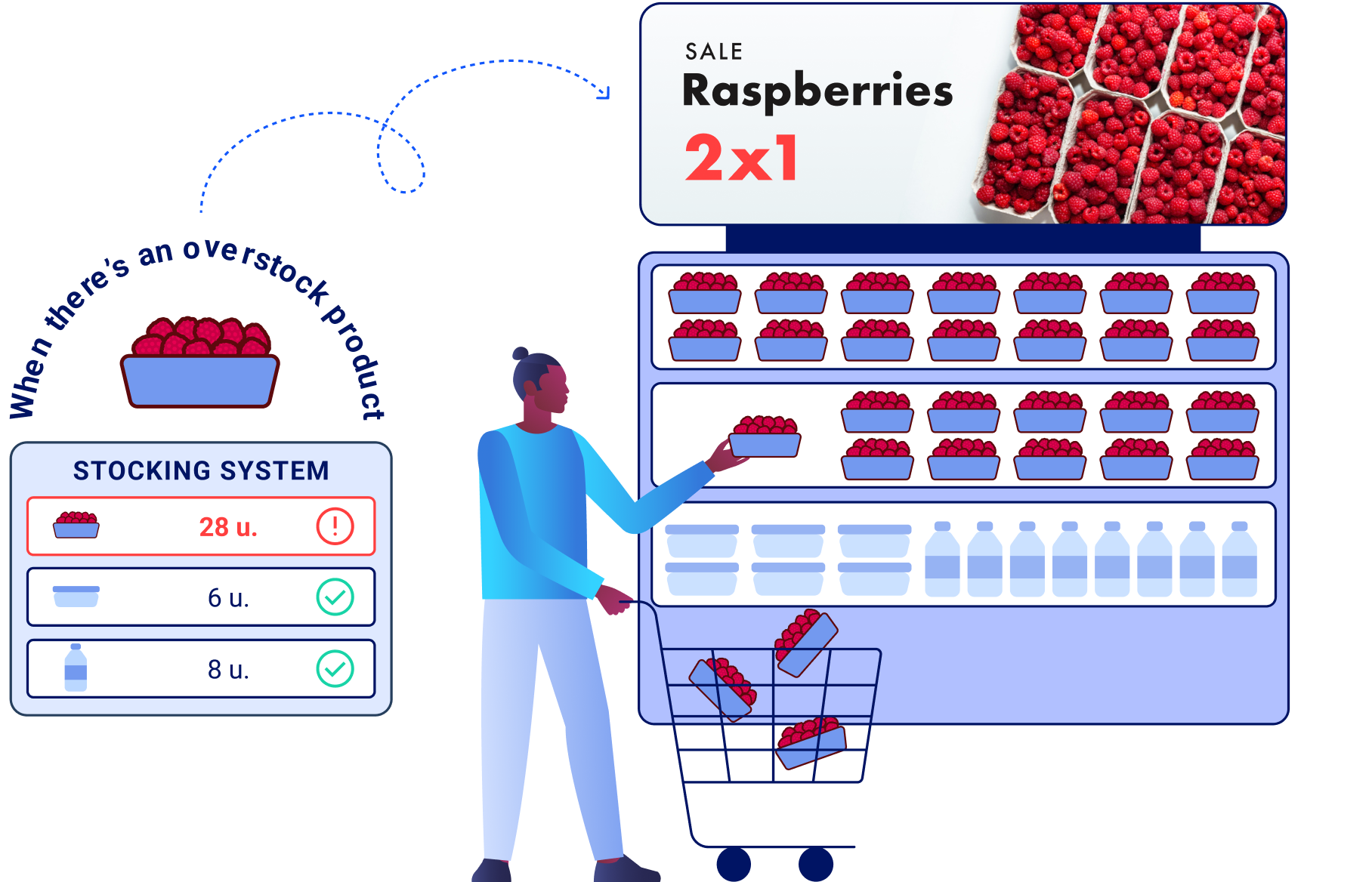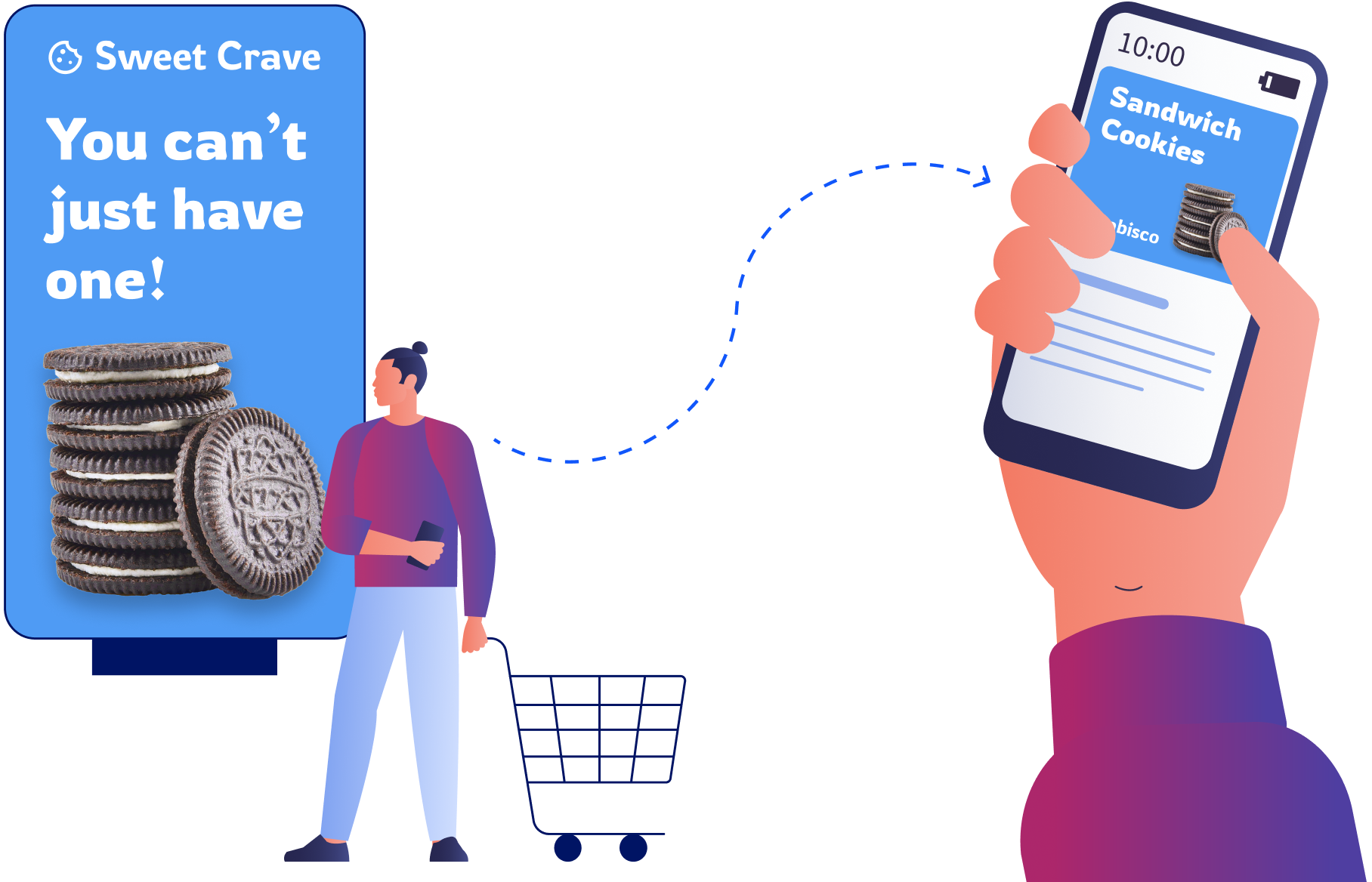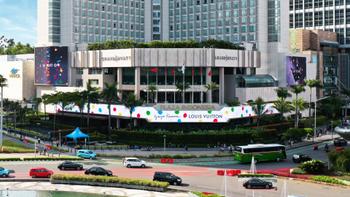In the fast-paced world of retail, staying ahead means more than just keeping up with trends — it’s about leading the charge. As e-commerce expands, brick-and-mortar stores continue to hold their ground, with 83.7% of this year’s retail sales still happening in-store. That’s a golden opportunity for retailers to directly connect with customers when they’re most ready to buy — at the point of purchase.
In-store retail media networks (RMNs) engage shoppers when they’re in decision-making mode, delivering tailored messaging that boosts interest and drives action. With the ability to reach up to 70% larger audiences compared to traditional digital channels, in-store media plays a crucial role in enhancing the shopping experience. It seamlessly bridges the gap between online and in-store, ensuring your brand stays top of mind.
Integrating in-store media into your RMN strategy is more than just a smart move — it’s essential for growth and long-term success in today’s competitive retail environment.
Jump to:
- Why prioritize in-store retail media?
- How technology is disrupting the in-store experience
- The current state of in-store RMNs: Challenges retailers face
- 3 reasons to integrate in-store signage as part of your RMN
Why prioritize in-store retail media?
“Retail media” can have various meanings depending on who you ask, but we like to keep it simple: it’s a way to reach your customer right at the point of purchase or point of choice.
While online retail media has made huge strides in recent years, there’s a massive opportunity to bring that same digital innovation into physical stores.

Benefits include:
Elevated shopping experience
In-store media like product demos, end-cap displays, and interactive kiosks can transform a retail atmosphere, creating a more engaging shopping experience. Printed posters and digital screens guide customers through the store, highlighting sections, promotions, or featured products. Dynamic digital signage can also display tailored advertisements and promotions based on real-time data.
Increased sales
Effective in-store advertising drives impulse purchases and upsells products, especially in categories like food and groceries, which account for a significant proportion of Americans’ impulse buys. Digital signage in grocery stores is an excellent way to capitalize on this. By highlighting promotions and new arrivals, retailers can boost sales and increase transaction value. In fact, a 2023 Insider Intelligence survey found that 31.5% of U.S. shoppers who discovered a new item while browsing in-store purchased it immediately.
Data collection and insights
In-store media integrates with digital tools to gather customer behaviour and preferences. This data helps refine marketing strategies, optimize store layouts, and improve inventory management. Additionally, it enables real-time, audience-based programmatic bidding and activation for digital signage, offering retailers new opportunities to monetize their in-store display networks.
Supporting omnichannel strategies
In-store media can complement online and mobile marketing efforts, creating a cohesive brand experience across all channels forming an omnichannel retail media network. For example, digital signage can promote exclusive online offers or integrate with loyalty programs. Additionally, DOOH ads can reinforce social media campaigns by boosting KPIs like brand relevance, likability, and authenticity.
Alternative Revenue Stream
Retailers can monetize their media inventory with both endemic advertisers—brands that align with the environment—and non-endemic brands seeking to reach new audiences while retaining full control over campaigns. This approach diversifies revenue, mitigates risk, and maximizes asset utilization, creating opportunities to fund internal projects and boost profitability. Additionally, real-time, audience-based programmatic bidding for digital signage opens new avenues to further monetize in-store display networks by delivering highly targeted, dynamically adjusted ads.

How technology is disrupting in-store experiences
Today, the spotlight is on crafting seamless omnichannel experiences that blend the best of digital and physical retail. Personalized advertising, using digital signage, in-store analytics, and mobile marketing, enhances customer engagement and makes in-store interactions memorable.
Tech advancements include:
- Real-time data analytics: Real-time data analytics allows for monitoring customer behaviour and preferences, enabling quick adjustments to in-store promotions and product placements. This leads to more personalized experiences, improving customer satisfaction and driving sales.
- Dynamic content delivery: Retailers can now implement responsive digital displays that update in real-time to showcase personalized offers and relevant content based on customer behaviour. Brick-and-mortar stores can also incorporate interactive elements like touchscreens and augmented reality (AR) to create an immersive in-store experience.
- Dwell time analysis: Dwell time analysis helps identify areas of the store that attract or lose customer interest, enabling optimization of store layout, product placement, and promotions. By enhancing high-traffic zones and addressing low-engagement areas, stores can create a more intuitive and engaging shopping experience, encouraging longer visits and boosting sales.
- Unified data sources: Integrating all real-time data streams into a single, unified tech stack allows retailers to create a comprehensive view of customer preferences across all touchpoints. This integration helps streamline inventory management, tailor promotions, and provide seamless service, enhancing overall customer satisfaction and loyalty.
Leveraging these innovations streamlines operations and gives retailers a competitive edge, allowing them to adapt to changing trends and stay ahead in the fast-paced retail landscape.
READ: Learn how to enhance the in-store retail experience with digital signage.
The current state of in-store RMNs: Challenges and opportunities for retailers
In-store advertising plays a crucial role in retail marketing by capturing customers’ attention as they shop. From point-of-sale displays to promotions, audio, and signage, it’s designed to boost sales. However, despite its potential, it’s often underutilized and not fully integrated with broader marketing strategies. Here are some of the challenges retailers encounter when implementing and optimizing in-store media.
Strategic allocation and resource challenges
Keeping up with rapidly changing tech and consumer shopping trends can make investing in the latest technologies expensive and risky. Many retailers have been burned by significant investments in groundbreaking digital technologies, only to see them replaced or marginalized by new inventions a year later.
Cross-channel data sharing challenges
Retailers’ and brands’ communication channels often remain siloed and disconnected, operating independently with separate systems and data. This makes it difficult for marketers to provide customers with real-time, personalized, and relevant information at the right moment via the right channels, which is crucial.
Tech integration challenges
Retailers often manage various solutions and vendors for customer communication without coordination or strategic planning. This patchwork approach makes it harder to connect with customers effectively and adds to the fragmentation currently seen in retail media. Many in the industry have cited a lack of standardization as the biggest challenge of 2024.

3 reasons to integrate in-store media as part of your RMN
Merging in-store media with your broader retail media network offers more than just standalone digital signage. By tying in-store media with your first-party RMN data, you craft a unified and personalized experience that drives engagement and boosts sales wherever your customers shop.
1. Consumer-focused strategies enable personalized in-store targeting
To deliver a standout retail experience, you need more than just a top-notch eCommerce setup—though that’s often a great starting point for building your RMN. By integrating in-store media, you can personalize the shopping journey through relevant content that grabs attention and boosts conversion rates.
Improved customer engagement and loyalty
By leveraging first-party data, you can customize in-store ads to match individual preferences, enriching the shopping experience and making customers feel appreciated. Integrating in-store media with your RMN ensures consistent messaging across all channels, which builds trust and loyalty by presenting a unified brand that meets customer needs.
Imagine a clothing retailer using this approach: a loyal customer receives a mobile alert about a special event featuring items similar to their past purchases. In-store digital displays showcase complementary products and offer exclusive discounts and styling tips. An interactive kiosk lets customers check their loyalty points, redeem rewards, and give feedback, boosting engagement and gathering valuable insights.
Higher conversion rates and increased sales
According to a 2024 U.S. survey report by Deloitte Digital, nearly three-quarters of consumers say they’re more likely to purchase from brands that deliver personalized experiences—and they spend 37% more with those brands. Meanwhile, over one-third of Gen Zers said their preferred way to receive personalized marketing was in a store.
Picture a shopper entering a grocery store. As they head towards the dairy aisle, a digital display activates, showcasing a promotion for a new yogurt brand. This ad is tailored in real-time, based on excess inventory and the shopper’s frequent yogurt purchases. It features a limited-time discount and highlights the yogurt’s health benefits, directly targeting the shopper’s preferences. Tempted by the offer, the shopper adds the yogurt to their cart and enjoys the discount. The store moves inventory efficiently and boosts the shopper’s basket size and satisfaction.
2. Integrating real-time data offers advanced measurement and optimization of campaigns
Real-time data transforms how you measure ad performance across your network, offering instant insights into customer interactions and ad effectiveness. Linking in-store media with your RMN allows you to track what’s working and adjust as needed, keeping your marketing sharp and relevant. If an in-store promo isn’t performing well, you can quickly update the content, change the display location, or modify incentives. This flexibility keeps campaigns aligned with customer preferences and market trends, while A/B testing different strategies helps fine-tune your approach for optimal results.
For example, Walmart uses in-store sensors and AI to adjust digital signage based on customer traffic patterns, ensuring that the most relevant ads are displayed at peak times. This real-time approach allows Walmart to quickly respond to market changes and customer demand, optimizing their pricing and promotional campaigns for maximum profitability. A 2023 AIScreen case study of Walmart’s integrated digital signage implementation revealed a 50% improvement in promotional effectiveness and a 30% enhancement in customer wayfinding.
3. Unifying your data sources opens up new monetization opportunities
Bringing together all data sources in your retail media network unlocks new revenue opportunities. By combining in-store media with insights like online behaviour, purchase history, and customer demographics, you gain a complete view of your customers. This 360-degree perspective allows you to create highly targeted advertising strategies that appeal to brand partners aiming to reach specific audience segments.
With unified data, you can also develop innovative cross-channel marketing campaigns that blend in-store and online experiences. For instance, you can offer brands the chance to run coordinated campaigns, where in-store promotions are backed by online ads, email marketing, and social media engagement. This multi-channel approach ensures consistent messaging and amplifies the campaign’s impact, driving higher engagement and conversion rates. The value of these integrated campaigns makes brands more likely to invest in your retail media network.
Practical steps
To integrate in-store advertising with other channels, consider the following steps:
- Invest in integrated data platforms: Choose a comprehensive in-store digital marketing platform that can consolidate data from various sources, including in-store interactions, online behaviour, purchase history, and customer demographics.
- Enhance in-store media infrastructure: Upgrade your in-store media infrastructure to support dynamic content delivery based on real-time data. Specifically, install digital signage that delivers personalized ads and promotions to individual customers.
- Implement advanced analytics tools: Use advanced analytics tools to analyze unified data, identifying key customer segments, preferences, and behaviours. Share these insights with brand partners and merchandisers to help them optimize product offerings and marketing strategies.
- Enable data-based programmatic bidding and activation: Leverage in-store data to offer personalized ad slots that align with customer preferences and behaviours. Then, sell targeted ad space to brands based on these real-time customer insights, allowing them to reach their ideal audience.
- Continuously monitor and optimize: Regularly monitor the performance of your (and your partners’) in-store media and marketing campaigns using real-time data. Continuously refine and optimize your strategies based on performance metrics and customer feedback.
Want to add in-store retail media to your RMN strategy?
Unlock new revenue and increase shopper satisfaction with contextual in-store ads. Learn more here.






